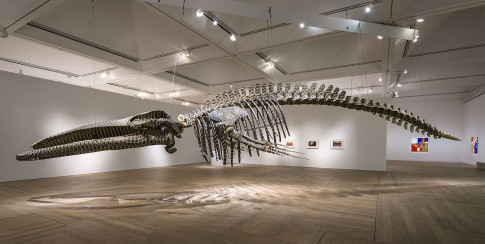
Gabriel Orozco, 2013 Photo: Rudolf Sagmeister
Text by Pablo Soller Frost, from the catalogue
One thing that marvels me about Gabriel is his astonishing capacity to pour new water, so to speak. It is the same spring, but the water is always new. Gabriel has worked with bone, plant, stone, gold, wood, wax, sand, dust, ink, paper, metals, compasses, scissors, pencils, garbage, cameras.
His work spirals. He likes to move. He likes movement and the stillness that those forces bring about. His art is about that: the incomprehensible music of the stars symbolized in fractal patterns. But that is not all: he has a poet’s soul in the sense that he grasps all the gifts bestowed upon him by sheer chance in the streets, in the garbage containers (as in Penske Work Project). He who wants to find, must first look. And Gabriel looks, intently. He watches.
Gabriel is a keen observer of nature, and I believe that he really finds delight in it: in streams, beaches, mangroves. But he is there to find the lines that connect according to the strict laws of the Italian Renaissance prescriptions on perspective or the even more strict laws of Newton. This is evident from Black Kites to the skeleton of the whale that hangs in Mexico’s City Public Library. It is even more perceivable in The Atomists in which the photographs appearing in Sports diaries and magazines showing the action of humans performing or struggling in a match or a game were overlaid by circles and semicircles, in duotone, if I remember correctly, and those new, superimposed figures expressed in a very Euclidian way, the nature of the effort conveying a beautiful universe of sheer forces.
His concern over form does not preclude the importance he gives to matter. In an age in which violence pervades the arts, there is no malevolence in Gabriel’s work. On the contrary. There is always a sense of hope, even if there is always irony. And that irony can be extremely sharp, as in the famous empty box, or his first exhibition at Marian Goodman clearly show. Those made him a relative of the surrealists in the sense that provocation has been, since the 18th century, an essential part of the arts.
His experience with boomerangs seems to me like a reflection of a reflection. You throw the boomerang away; its ellipse may or may not be perfect; it may or may not return to your hand; but it is always you who tries to master the instrument and the instrument, although being always the same, bears the brunt of all its experiences. It is a physical event recorded by our senses. And it is one that signifies.
I think Gabriel finds significance in almost everything, from flints to dried, decaying cactuses. For me that exhibition, of the dead things he brought from the desert, stands tall among the many extraordinary exhibitions of this Mexican artist, the one who is truly the inheritor of “Los Tres Grandes del Muralismo Mexicano,” José Clemente Orozco, Diego Rivera, and David Alfaro Siqueiros. And I say this without a hint of irony. The vision is global, but it is rooted locally. I know it is a cliché, but sometimes, a French diplomat once said, clichés are vital.
And there is a sense of humour, which I might perhaps explain as a sense of sharing. Gabriel wants to share: his vision, his insights into the vast universe. He neither dissects nature, nor people, nor situations. He watches and, as cosmographers before him, Gabriel brings us neat, orderly objects and pictures of things afar, of things forgotten, of things eternal.
Text by Pablo Soler Frostfrom the catalogue ”Gabriel Orozco – Natural Motion”


